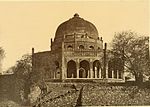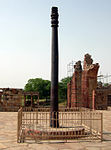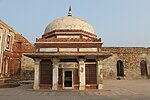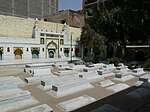Yogmaya Temple

Yogmaya Temple, also Jogmaya temple, is a Hindu temple Shakti Peetha dedicated to the goddess Yogmaya, also considered to be a sister of Krishna as she took avatar as Vindhyavasini, and situated in Mehrauli, New Delhi, India, close to the Qutb complex. According to local priests and native records, this is one of those 27 temples destroyed by Mahmud Ghazni and later by Mamluks and it is the only surviving temple belonging to pre-sultanate period which is still in use. Hindu king Samrat Vikramaditya Hemu reconstructed the temple and brought back the temple from ruins. During Aurangzeb's reign a rectangular Islamic Style hall was added to the temple. Though its original (300-200 BC) architecture could never be restored after its destruction by Islamic rulers, but its reconstruction had been carried out repetitively by the locals. Yogmaya or Jogmaya is considered, an aspect of Maya, the illusionary power of God. The temple is also venue of a large congregation of devotees during the Navratri celebrations. The present temple was restored in early 19th century and may be the descendant of a much older Devi shrine. Adjacent to the temple lies, a water body, johad, known as Anangtal Baoli, after King Anangpal Tomar, and covered by trees from all sides The temple is also an integral part of an important inter-faith festival of Delhi, the annual Phool Walon Ki Sair.
Excerpt from the Wikipedia article Yogmaya Temple (License: CC BY-SA 3.0, Authors, Images).Yogmaya Temple
Geographical coordinates (GPS) Address Nearby Places Show on map
Geographical coordinates (GPS)
| Latitude | Longitude |
|---|---|
| N 28.525 ° | E 77.1825 ° |
Address
110030 , Sanjay Van
Delhi, India
Open on Google Maps









